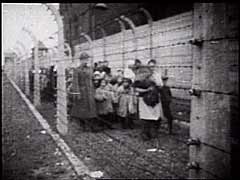http://www.ushmm.org/wlc/en/article.php?ModuleId=10007056
Initially, the SS authorities marked prisoners who were in the infirmary or who were to be executed with their camp serial number across the chest with indelible ink. As prisoners were executed or died in other ways, their clothing bearing the camp serial number was removed. Given the mortality rate at the camp and practice of removing clothing, there was no way to identify the bodies after the clothing was removed. Hence, the SS authorities introduced the practice of tattooing in order to identify the bodies of registered prisoners who had died.
Originally, a special metal stamp, holding interchangeable numbers made up of needles approximately one centimeter long was used. This allowed the whole serial number to be punched at one blow onto the prisoner's left upper chest. Ink was then rubbed into the bleeding wound.
When the metal stamp method proved impractical, a single-needle device was introduced, which pierced the outlines of the serial-number digits onto the skin. The site of the tattoo was changed to the outer side of the left forearm. However, prisoners from several transports in 1943 had their numbers tattooed on the inner side of their left upper forearms. Tattooing was generally performed during registration when each prisoner was assigned a camp serial number. Since prisoners sent directly to the gas chambers were never issued numbers, they were never tattooed.
Tattooing was introduced at Auschwitz in the autumn of 1941. As thousands of Soviet prisoners of war (POWs) arrived at the camp, and thousands rapidly died there, the SS authorities began to tattoo the prisoners for identification purposes. At Auschwitz II (Birkenau), the SS staff introduced the practice of tattooing in March 1942 to keep up with the identification of large numbers of prisoners who arrived, sickened, and died quickly. By this time, the majority of registered prisoners in the Auschwitz complex were Jews. In the spring of 1943, the SS authorities throughout the entire Auschwitz complex adopted the practice of tattooing almost all previously registered and newly arrived prisoners, including female prisoners. Exceptions to this practice were prisoners of German nationality and “reeducation prisoners,” who were held in a separate compound. “Reeducation prisoners,” or “labor-education prisoners,” were non-Jewish persons of virtually all European nationalities (but at Auschwitz primarily Germans, Czechs, Poles, and Soviet civilians) who had run afoul of the harsh labor discipline imposed on civilian laborers in areas under German control.
The first series of prisoner numbers was introduced in May 1940, well before the practice of tattooing began. This first series was given to male prisoners and remained in use until January 1945, ending with the number 202,499. Until mid-May 1944, male Jewish prisoners were given numbers from this series. A new series of registration numbers was introduced in October 1941 and remained in use until 1944. Approximately 12,000 Soviet POWs were given numbers from this series (some of the POWs murdered at Auschwitz were never registered and did not receive numbers). A third series of numbers was introduced in March 1942 with the arrival of the first female prisoners. Approximately 90,000 female prisoners were identified with a series of numbers created for female prisoners in March 1942 until May 1944. Each new series of numbers introduced at Auschwitz began with “1.” Some Jewish prisoners (but not all) had a triangle tattooed beneath their serial number.
In order to avoid the assignment of excessively high numbers from the general series to the large number of Hungarian Jews arriving in 1944, the SS authorities introduced new sequences of numbers in mid-May 1944. This series, prefaced by the letter A, began with “1” and ended at “20,000.” Once the number 20,000 was reached, a new series beginning with “B” series was introduced. Some 15,000 men received “B” series tattoos. For an unknown reason, the “A” series for women did not stop at 20,000 and continued to 30,000.
A separate series of numbers was introduced in January 1942 for “reeducation” prisoners who had not received numbers from the general series. Numbers from this new series were assigned retroactively to “reeducation” prisoners who had died or been released, while their superseded general-series serial numbers were reassigned to new “general” arrivals. This was the only instance in the history of Auschwitz of numbers being “recycled.” Approximately 9,000 prisoners were registered in the “reeducation” series. Beginning in 1943, female “reeducation” prisoners were given serial numbers from their own new series, which also began with “1.” There were approximately 2,000 serial numbers in this series.
Beginning in February 1943, SS authorities issue two separate series' of number to Roma (Gypsy) prisoners registered at Auschwitz: one for the men and one for the women. Through August 1944, 10,094 numbers were assigned from the former series and 10,888 from the latter. Gypsy prisoners were given the letter Z (“Zigeuner” is German for Gypsy) in addition to the serial number.
The camp authorities assigned more than 400,000 prisoner serial numbers (not counting approximately 3,000 numbers given to police prisoners interned at Auschwitz due to overcrowding in jails who were not included in the daily count of prisoners).










